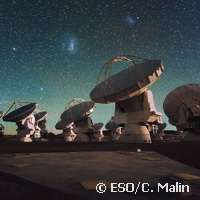ALMA observatory opens window to universe's darkest secrets

The Atacama Large Millimeter/submillimeter Array (ALMA) in the Chilean Andes allows astronomers to peer into some of the darkest and furthest parts of the universe, unveiling some of its previously hidden secrets.
ALMA produces high-quality interferometer images at wavelengths in the range between infrared light and radio waves. The observatory, a partnership of European, North American, and East Asian countries, was officially inaugurated in March 2013.
The EU project ALMA ENHANCEMENT ('Enhancement of ALMA early science') was part of Europe's contribution to the observatory. The project, coordinated by the European Southern Observatory, built the hardware and software components that produce high fidelity images and high resolution measurements of water vapour spectral lines.
Water is an important constituent of star forming regions and comets, so measuring the best and most complete data set of their spectral lines is crucial to discovering more about the universe's origins.
Gie Han Tan, ALMA's system engineer and European front end project manager at the European Southern Observatory, says ALMA's construction, which started in 2003, was quite a feat and marked a milestone in international scientific cooperation.
"In about 10 years, the largest and most advanced millimetre and sub-millimetre radio observatory has been built from scratch in the remote Atacama desert in Chile," he says.
ALMA ENHANCEMENT played its part by contributing to some of the observatory's early scientific work, which began in 2011, and giving Europe's astronomers access to state-of-the-art instrumentation.
"Under ALMA, European industry and research organisations have developed advanced technology such as receivers and antennas that could have potential spin-off for other, commercial, applications," adds Tan. The project has also injected hundreds of millions of euros into the European construction industry.
Now, the ALMA observatory is producing a steady stream of scientifically significant results. These include giving scientists the best view yet of an embryonic monster star in the process of formation, and pinpointing the location of more than 100 of the most fertile star-forming galaxies in the universe.
Another breakthrough was the detection of sugar molecules in the gas surrounding a young star, revealing that these building blocks of life could be incorporated into any planets forming around the star.
In July, the radio telescope gave astronomers the best view of how vigorous star formation can blast gas out of a galaxy and starve future generations of stars of the fuel they need to grow.
These findings and many others that continue to emerge - could help scientists and citizens - in many ways.
"ALMA develops society and furthers education by contributing to basic science such as in the areas of physics and chemistry," says Tan.
With the inauguration this year, ALMA is officially open to the global astronomical community, which will benefit from its unique capabilities for at least 30 years. The world can expect even more exciting and unprecedented discoveries about our universe.
More information: www.almaobservatory.org/
Provided by CORDIS





















